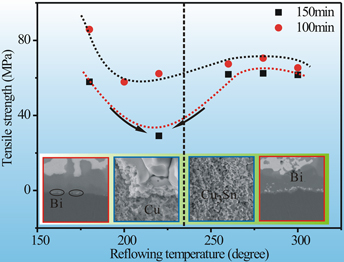Crossref Citations
This article has been cited by the following publications. This list is generated based on data provided by
Crossref.
Zhang, Q. K.
Zou, H. F.
and
Zhang, Z. F.
2011.
Influences of Substrate Alloying and Reflow Temperature on Bi Segregation Behaviors at Sn-Bi/Cu Interface.
Journal of Electronic Materials,
Vol. 40,
Issue. 11,
p.
2320.
Wang, Fengjiang
Huang, Ying
and
Du, Chengchao
2016.
Mechanical properties of SnBi-SnAgCu composition mixed solder joints using bending test.
Materials Science and Engineering: A,
Vol. 668,
Issue. ,
p.
224.
Wang, Fengjiang
Zhou, Lili
Wang, Xiaojing
and
He, Peng
2016.
Microstructural evolution and joint strength of Sn-58Bi/Cu joints through minor Zn alloying substrate during isothermal aging.
Journal of Alloys and Compounds,
Vol. 688,
Issue. ,
p.
639.
Sharma, Ashutosh
Srivastava, Ashok K.
Lee, Kwan
and
Ahn, Byungmin
2019.
Impact of Non-Reactive Ceria Nanoparticles on the Wettability and Reaction Kinetics Between Lead-Free Sn–58Bi and Cu Pad.
Metals and Materials International,
Vol. 25,
Issue. 4,
p.
1027.
Wang, Kaipeng
Wang, Fengjiang
Huang, Ying
and
Qi, Kai
2019.
Comprehensive Properties of a Novel Quaternary Sn-Bi-Sb-Ag Solder: Wettability, Interfacial Structure and Mechanical Properties.
Metals,
Vol. 9,
Issue. 7,
p.
791.
Xiong, Mingyue
Zhang, Liang
Sun, Lei
He, Peng
and
Long, Weimin
2019.
Effect of CuZnAl particles addition on microstructure of Cu/Sn58Bi/Cu TLP bonding solder joints.
Vacuum,
Vol. 167,
Issue. ,
p.
301.
Liu, Yang
Ren, Boqiao
Xue, Yuxiong
Zhou, Min
Cao, Rongxing
Chen, Penghui
and
Zeng, Xianghua
2021.
Pressure-assisted soldering of copper using porous metal-reinforced Sn58Bi solder.
Journal of Materials Science: Materials in Electronics,
Vol. 32,
Issue. 14,
p.
18968.
Liu, Yang
Ren, Boqiao
Xue, Yuxiong
Zhou, Min
Cao, Rongxing
and
Zeng, Xianghua
2021.
Improvement on the mechanical properties of eutectic Sn58Bi alloy with porous Cu addition during isothermal aging.
Materials Research Express,
Vol. 8,
Issue. 7,
p.
076302.
Yadav, Manu
Alghoul, Thaer
Thekkut, Sanoop
Das, Ronit
Greene, Christopher
Borgesen, Peter
Sakib, A. R. Nazmus
Wentlent, Luke
and
Joshi, Shantanu
2022.
Strength and Isothermal Fatigue Resistance of SnBi/SnAgCu Joints Reflowed at Low Temperatures.
Journal of Electronic Packaging,
Vol. 144,
Issue. 3,
Wang, Yi-Wun
Liang, Hua-Tui
Chang, Kai-Chia
Wu, Guo-Wei
Tseng, Tzu-Ting
and
Chen, Yi
2023.
Partial Segregation of Bi and Microvoid Formation on a Pure Cu Substrate After Solid–Solid Reactions.
Journal of Electronic Materials,
Vol. 52,
Issue. 6,
p.
4000.
Ali, Hafiz Waqas
Danovitch, David
Drouin, Dominique
Langlois, Richard
and
Martel, Robert
2023.
Solder Joint Reliability of Fully Homogenised SAC-SnBi Low Temperature BGA Interconnections using Solid Liquid Inter-Diffusion (SLID).
p.
858.
ZHANG, Tian-yu
CHENG, Qing
ZHU, Heng-yu
WEI, Qin-qin
and
XU, Xian-dong
2023.
Microstructure characterization of (Sn1−Zn )57(In0.78Bi0.22)43 low melting point lead-free solder materials.
Transactions of Nonferrous Metals Society of China,
Vol. 33,
Issue. 1,
p.
201.
Wang, Yi-Wun
Tseng, Tzu-Ting
Chang, Kai-Chia
Wu, Guo-Wei
and
Liang, Hua-Tui
2023.
Microstructural observation of Bi67In reacting with Cu for microelectronic interconnects.
Journal of the Taiwan Institute of Chemical Engineers,
Vol. 151,
Issue. ,
p.
105099.





